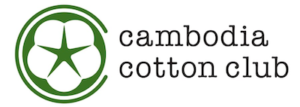The Global Organic Textile Standard (GOTS), the world's most stringent organic cotton certification standard, states that as long as 70% of the cotton used is "organically grown" to meet GOTS standards, even if the remaining 30% does not meet GOTS standards. It is almost certain that GOTS-certified cotton includes conventional cotton, which is considered problematic because of its "high use of pesticides, which is harmful to the environment and farmers' health. The same is true for other certifying organizations.
Even its organic cultivation allows the use of large amounts of toxic chemicals in agricultural and industrial processes, such as pesticides and dyeing, with no restrictions on the total amount. This brings us to the question, "What exactly is organic cotton?" In 2008, I had applied to a French organic cotton certification organization to have my Cambodian cotton certified. At the time, I had no idea that such a "trick" existed.
Organic cotton certifiers are not official. They are companies that profit from the certification business. Members of non-profit organizations that promote the cultivation of organic cotton are also members of companies that sell cotton products. The same is true in Japan.
The organic cotton certification business model is to bring replacement demand to the apparel market while promoting "organic cotton is great" and getting consumers to pay more for it.
The peak of this business is seen in the period from 2009 to 2010. India, which had produced half of the world's organic cotton, stopped planting organic cotton by 47% the following year.
This is due to the reality that organic certification organizations demand high certification fees from farmers. Even if a farmer obtains organic certification, the purchase price from the farmer is only 10% higher than that of conventional cotton.
Organic cotton also has a market price between producers and buyers. According to a friend of mine who runs an extensive cotton business from seed to cloth in the Deccan Plateau of India, the market price is now gradually declining.
I believe that organic cotton products that appeared on the market around 2005 were expensive. It was something like, "In order to protect the global environment and the cotton farmers who suffer from pesticide poisoning, we should switch to organic cotton instead of pesticide-soaked cotton produced by conventional cultivation methods. For this reason, it is inevitable that the products will be expensive,” was sales talk.
Again, "certified cotton" with organic certification is only about 10% more expensive than conventionally grown cotton. In the actual international market (Port of New York), the price of 1 kilo of kuriwafers (the fiber part with the seeds removed) is about 35 to 40 yen per kilo. The price is only 10% higher.
The weight of cotton used for a single T-shirt is approximately 250 to 300 grams. In the past, the price of some of these T-shirts was close to 10,000 yen once they were certified organic, so if you do a little math, you can see how high the profit margin is.
The gradual decline in the price of organic cotton raw materials means that the "story" of protecting the global environment and farmers' health by reducing pesticides has been consumed. It is becoming increasingly clear that organic cotton has been an illusion.
At the same time, major mass merchandisers began to focus on organic cotton sales. Trading companies and spinning companies with trading company functions, which until then had avoided distributing organic cotton to major mass merchandisers as much as possible because it would lower the brand value, sensed the shadow of the organic brand and began distributing organic cotton to mass merchandisers. It was the unanimous opinion of many people involved that "organic alone would no longer be enough to sell things.
Massive use of toxic pesticides, desertification of farmland, farmers dying of poisoning, the cycle of poverty.... Those problems have been left behind. Mass cultivation and mass production of cotton, followed by mass disposal. As long as this vicious cycle continues, cotton growers in distant countries will continue to make unrewarding efforts for the rest of their lives. They will eventually have to pay the price for polluting the topsoil that wraps the earth like a thin layer of skin.
(END)
